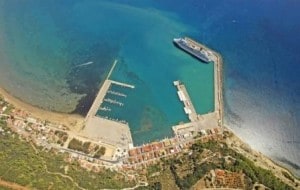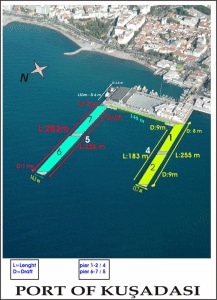 Captain Albert Schoonderbeek
Captain Albert Schoonderbeek
With a flat calm sea and the sun rising over the horizon we arrived at 07.00 at the pilot station of Katakolon. Ahead of us was the MSC Musica which was scheduled to dock at the outer breakwater. This is a 90.000 ton ship and carries 2500 lower beds and over 3000 when full. That spoiled it a little bit, as Katakolon is a little bit too small to take such an invasion. However she was only going to stay to until 2 pm. and thus our guests had the town all to themselves during the afternoon. The good news was that we, being the smaller ship, could dock at the downtown pier and that meant less then a 1000 feet to walk to the town with it’s shops and tavernas. Katakolon is a very nice place to go to.
The only thing with the downtown dock is, is that it is sitting on a crack in the earths crust and sulpher fumes come up through the water. Not much, but just enough that when you step of the gangway, you get a whiff of rotten eggs. I announced that yesterday to the guests so that they would know it was not sewage or something. It is a sort of low density sulpheric gas. If you go to thermal bath you have to pay an arm and an egg smell but here in Katakolon you get it for free.

The new pier is one sticking out from the promenade of Katakolon. The bigger ships dock at the inner breakwater.
A peculiar thing was today that my blog was involved in bringing two old friends together. A while a go I received on the Captain Albert email a request from a gentleman who was trying to trace the pilot in Katakolon. He had spent a long period in the town in 1998 when he was there stationed with a tugboat. However he did not know if the pilot was still the same and where he lived. So this morning I gave a print out of the email to the same pilot as then and of course he remembered this particular young man. When the pilot returned to the ship on departure, he told me he had already sent an email to Romania to get in touch again.
As with most small ports, the pilots are multi taskers who run several operations at the same time, just being a pilot does not bring enough money in the kitty. So he has a very nice restaurant in the town on the promenade. He owns the pilot boat and he has a share in the tugboat stationed in the port. The pilot boat can also be used as a ships tender and quite often employed by the cruise ships at anchor. I remember using it with the old Noordam in 2001, when I was pressed for time. I got my own tenders home early and then used the pilots tender for the final run which saved me at least 30 minutes on departure. You have to announce it early though as the pilot has to make sure that his boat driver does not go for a “happy day” ashore. Most of the time a “very happy day”.
I always have to laugh when this pilot is standing next to me, as you can put the clock on it, that by 07.30 his cell phone rings with his wife on the line. Telling him to hurry up with docking the ship as he has to take the children to school and to open up the restaurant. So I try to have the gangway out by 07.25 to make sure that he does not run into a domestic argument with his wife or his mother who is the cook of the restaurant. You can spend a leisurely day in Katakolon but the main attraction is going on tour to Olympia. There is also a good train connection for going in land but while there were close to 4000 people in town, the railroad workers thought that this was the most appropriate time to go on strike and so the trains were not running.
We were ready to sail on time and with a bit of a windy departure, I backed the Prinsendam out of the harbour and 20 minutes later we were on our way to Navplion which is located at the other side of the island. The Peloponnesus was originally a peninsula but since they dug the Corinth Canal it is now an island. We will travel during the night around the Southside of the island and by midnight go through the channel North of Kythira. This is the shortest route from the West Med to the East Med and to the Black sea and so we normally meet about a 100 ships here. As those ships are not always behaving I will have to be on the bridge for most of the night.
However the weather tomorrow in Navplion looks great. Sunshine all day, little wind and temperatures in the high 70’s. to low 80’s.
To access Captain Albert’s historical writings on Holland America Line as well as photos and additional information about Prinsendam and his sailing schedule, click here.
 Captain Albert Schoonderbeek
Captain Albert Schoonderbeek

